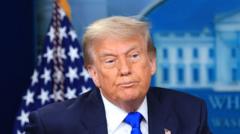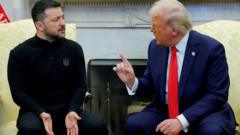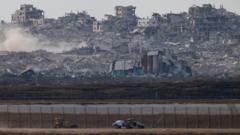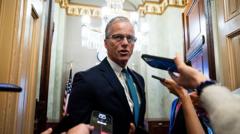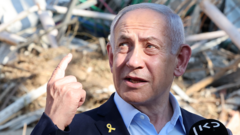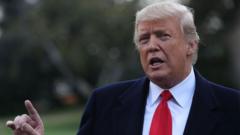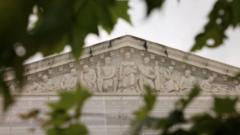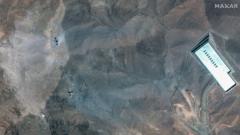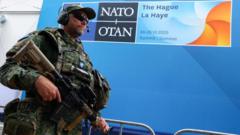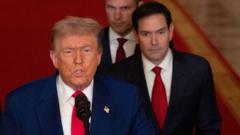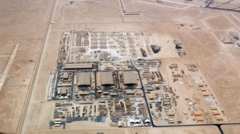As discussions around Air Force One evolve, Qatar's lavish offer has sparked debates over security modifications, the aging fleet, and the presidential travel experience.**
Transforming Air Force One: A Look at What's Inside and the Proposed Changes Ahead**
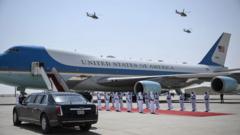
Transforming Air Force One: A Look at What's Inside and the Proposed Changes Ahead**
Examination of the interior of Air Force One and the implications of Qatar's offer for a new aircraft, including security, technological upgrades, and political ramifications.**
The Air Force One, the iconic presidential aircraft, is currently a subject of interest due to a potential overhaul brought on by Qatar's generous proposal. Most press members aboard do not get a full view of its luxurious interior as they inhabit the rear cabin while the presidential suite remains accessible only to a select few, often protected by armed Secret Service agents.
During Donald Trump’s recent Middle Eastern trip, the aircraft’s future was a hot topic. The press pool, with its limited access, bears witness to the aircraft's comforts: a cozy seating arrangement on par with first class, a stocked bathroom, and even Air Force One-branded snacks like M&Ms. The cabin, typically tuned to favored channels of the sitting president, is outfitted with screens that sometimes showcase sporting events, catering to the entertainment of those aboard.
However, the beauty of this royal jet may soon evolve if Trump embraces Qatar's offer, a $400 million 747-8 designation intended to serve as a “palace in the sky." The call sign “Air Force One” technically applies to any Air Force plane housing the president, yet the specific aircraft often imagined is the distinguished 747-200b, sporting colors chosen by Jackie Kennedy in the 1960s. Despite regular upgrades, the current 747s, which have been in operation since 1990, show signs of aging equipment and increasing maintenance costs.
Trump has expressed dissatisfaction about flying aboard outdated models and has sought innovative solutions. He has fast-tracked Boeing's creation of a new aircraft; however, construction delays mean its arrival may not coincide with his presidential term concluding in 2029. This predicament has spurred his interest in Qatar's proposal: a lavish foreign gift, stirring ethical concerns.
The practical adjustments necessary for a smooth transition from a foreign jet to an American-command aircraft include adding security features and communications systems suitable for presidential use that could take years and cost upwards of $1 billion to implement. The potential aircraft, with advanced technology and refueling capabilities, would face scrutiny, predominantly surrounding the implications of accepting such a gift.
As we anticipate the eventual retirement of the current aircraft, we reflect on its historical significance, housing various presidents during critical moments, including Bill Clinton, George W. Bush, and recently Joe Biden. Trump's tactical use of the plane for political rallies further highlights the significance of Air Force One in U.S. politics.
Despite its retrofitting needs and the political discourse surrounding it, Air Force One remains one of the most potent symbols of U.S. authority on a global stage—a multipurpose command center rather than merely a luxurious mode of travel.
During Donald Trump’s recent Middle Eastern trip, the aircraft’s future was a hot topic. The press pool, with its limited access, bears witness to the aircraft's comforts: a cozy seating arrangement on par with first class, a stocked bathroom, and even Air Force One-branded snacks like M&Ms. The cabin, typically tuned to favored channels of the sitting president, is outfitted with screens that sometimes showcase sporting events, catering to the entertainment of those aboard.
However, the beauty of this royal jet may soon evolve if Trump embraces Qatar's offer, a $400 million 747-8 designation intended to serve as a “palace in the sky." The call sign “Air Force One” technically applies to any Air Force plane housing the president, yet the specific aircraft often imagined is the distinguished 747-200b, sporting colors chosen by Jackie Kennedy in the 1960s. Despite regular upgrades, the current 747s, which have been in operation since 1990, show signs of aging equipment and increasing maintenance costs.
Trump has expressed dissatisfaction about flying aboard outdated models and has sought innovative solutions. He has fast-tracked Boeing's creation of a new aircraft; however, construction delays mean its arrival may not coincide with his presidential term concluding in 2029. This predicament has spurred his interest in Qatar's proposal: a lavish foreign gift, stirring ethical concerns.
The practical adjustments necessary for a smooth transition from a foreign jet to an American-command aircraft include adding security features and communications systems suitable for presidential use that could take years and cost upwards of $1 billion to implement. The potential aircraft, with advanced technology and refueling capabilities, would face scrutiny, predominantly surrounding the implications of accepting such a gift.
As we anticipate the eventual retirement of the current aircraft, we reflect on its historical significance, housing various presidents during critical moments, including Bill Clinton, George W. Bush, and recently Joe Biden. Trump's tactical use of the plane for political rallies further highlights the significance of Air Force One in U.S. politics.
Despite its retrofitting needs and the political discourse surrounding it, Air Force One remains one of the most potent symbols of U.S. authority on a global stage—a multipurpose command center rather than merely a luxurious mode of travel.




